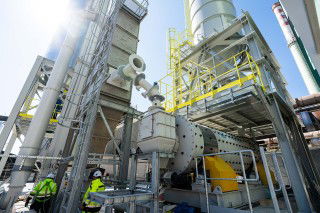HeidelbergCement has published its 2018 sustainability report in which it lays out its plans to produce CO2-neutral concrete by 2050 and its achievements in the area of sustainable cement and concrete production in 2018.
CO2 emissions
In terms of energy and climate protection, the group has reduced its specific net CO2 emissions in cement production by 1.4 per cent from 607.6kg CO2/t of cement to 599.2kg. It aims to reduce its CO2 emissions by 30 per cent by 2030, when compared with the 1990 baseline.
Its clinker ratio fell from 75.3 per cent to 74.7 per cent and the group continues to research the development of sustainable products. Its Climate Policy includes the aim to use 80 per cent of its R&D budget for the development of sustainable products.
The company’s use of alternative fuels edged up from 20.8 per cent to 21.7 per cent in 2018.
NOx, SOx and dust emissions
In addition, HeidelbergCement aims to reduce SOx and NOx emissions from its cement plants by 40 per cent and dust emissions by 80 per cent by 2030 when compared with the 2008 baseline.
Several investments were made in 2018 to reduce dust emissions. ESPs were replaced with bag filters at the company’s cement plants in Ennigerloh (Germany) and Ketton (UK) as well as on Line 2 in Pukrang (Thailand) and Line 4 at Citeureup (Indonesia). Specific dust emissions fell from 90g/t of clinker in 2017 to 80g in 2018.
To reduce NOx emissions, HeidelbergCement installed SCR systems at the Narsingarh and Yerraguntla works in India as well as implemented primary measures in Helwan (Egypt) and Aït Baha (Morocco). Group-wide specific NOx emissions dropped from 1373g/t of clinker in 2017 to 1263g/t of clinker one year later.
The old flue gas desulphurisation at Ribblesdale, UK, was replaced by a modern scrubber to improve SOx emissions reduction. On a group level, specific SOx emissions decreased from 367g/t of clinker in 2017 to 351g/t of clinker in 2018.
Land use and biodiversity
In terms of land use and biodiversity around 88 per cent of its cement business and 76 per cent of its aggregates quarries have now reclamation plans. The group aims to raise the figure to 100 per cent by 2030 at the latest. Furthermore 47 per cent of cement and 41 per cent of aggregate quarries have now biodiversity management plans in place and the company is steadily extending biodiversity monitoring to more quarries.
Water management
The group reduced its water consumption by 8.5 per cent from 35.2Mm3 to 32.2Mm3 across its businesses. Specific water consumption for cement declined from 306.5l/t in 2017 to 269.9l/t in 2018 while for clinker it fell from 403.5l/t to 355.4l/t over the same period.
